I want to extend a big thank you to Butterfly Conservation Europe for declaring #FebruaryButterflyMonth and livening up the last dregs of winter with a fantastic selection of 29 of Europe’s more than 450 butterfly species. As well as an assortment of great photographs from people all over Europe, there were useful identification tips, conservation information and stories from butterfly enthusiasts. Below are ten of the pictures I shared for #FebruaryButterflyMonth.
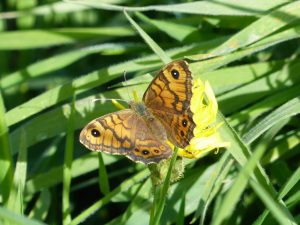
Wall Lasiommata megera, England
The lost generation?
In some parts of its range, the Wall may have up to four generations, but in the UK it is typically double-brooded. It is considered widespread and common across much of Europe: often living up to its name, as it lounges on rocks, bare earth or walls! Dig a little deeper however and it’s clear this butterfly’s fortunes are mixed, with some severe declines in northern and western Europe, including the UK.
One theory for this decline is a so-called developmental trap caused by our changing climate. Warmer weather triggers larvae of the second generation to pupate and emerge as adults in September rather than overwintering and emerging the following year. At this time there may not be sufficient food for their larvae to be able to survive the winter, potentially making them a ‘lost generation’.
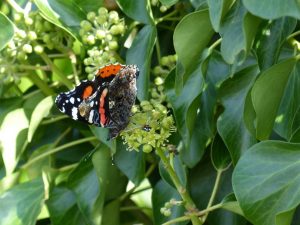
Red Admiral Vanessa atalanta, England
A vote for Ivy
A seasoned traveller, this powerful butterfly blazes a trail northwards from northern Africa and mainland Europe every spring and summer. Traditionally the Red Admiral was considered a resident only in the south of its wide range, with all northern records a result of migration. It does now occur as a permanent resident further north, including in southern England where it can successfully overwinter, however the vast majority of those seen in the UK will be as a result of immigration.
All travellers must return, and in the autumn, Red Admirals are frequently seen flying the flag for the importance of Ivy as a food source for late-flying pollinators, as they fuel up for their southbound journey.
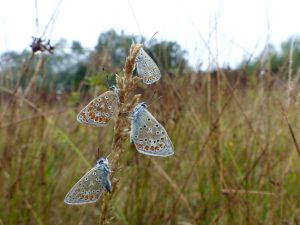
Common Blue Polyommatus icarus, England
Part of the crowd
A common and widespread butterfly across Europe, Common Blues can be found in large colonies. As with others in their family (Lycaenidae), the Common Blue can be found roosting communally, generally facing downwards, on the stems of grasses and other vegetation. The main theory for communal roosting in butterflies is that it may act as a predatory deterrent, and it is a strategy they can use overnight, but also at times when they are unable to fly due to low temperatures or poor weather.
Butterflies are reliant on heat from the environment, and use the base of their wings for temperature control. They will use different postures, from flattened to shut wings, and different behaviours, from basking to hiding in shady spots, depending upon their body temperature. I spotted this small group of Common Blues sitting out the cold and drizzle on a particularly unappealing survey day in southern England.
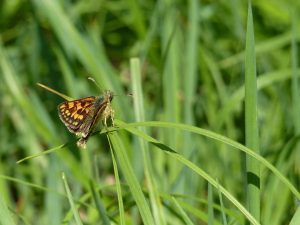
Chequered Skipper Carterocephalus palaemon, The Vercors
Places to be
The colourful Chequered Skipper is an extremely restless butterfly of open woodlands and wet grasslands. The males in particular are enthusiastic in defending their territory that they watch over from a favoured perch. This also gives them a good vantage point for spotting females, which they can then fly out and intercept.
The butterfly was lost from England in 1976 with several colonies still persisting in western Scotland. In the summer of 2018, 41 Chequered Skippers were reintroduced to Rockingham Forest in Northamptonshire, as part of the Back from the Brink project. Successful breeding was confirmed in 2019 and a third and final reintroduction is planned for summer 2020.
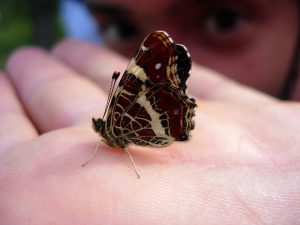
Map Araschnia levana, Czech Republic
A butterfly of two seasons
The Map’s name comes from its fantastically marked underside. It has two generations each year, but without reference to your books, you could mistake them for two separate species. The first brood of Maps (the levana form), which fly from May to June are bright orange and not dissimilar to a small fritillary. During July and August, a second generation of summer Maps take to the skies. These are the prorsa form, and with their black and white markings, look closer to one of the white admirals.
Seasonal dimorphism is seen in other butterflies, but the Map is a very exaggerated example. Research has demonstrated this striking difference is induced by day length, but no one has yet proved what the benefit may be to the Map of this mid-season outfit change
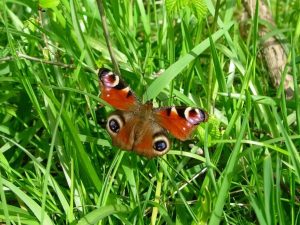
Peacock Inachis io, England
Shock and awe
Many butterflies choose passive means of defence, think of Commas and Brimstones that can easily disappear into the foliage. Not so the feisty Peacock. Although the underside of their wings are fairly inconspicuous, likening them to a dead leaf, the Peacock does not rely on this alone to deter potential predators. It also has a couple of active lines of defence up its sleeve. As David Bowie tells us, it’s ’bout sound and vision’.
The brightly coloured upperside makes for an effective deterrent against avian predators: its eye-spots perhaps fooling them into thinking there is a larger bird present. The Peacock has also adopted a behavioural strategy of rubbing its wings together to produce an impressively loud hiss (I shared a video of this for #FebruaryButterflyMonth). This soundtrack has been shown to be particularly effective against small mammals. The Peacock is indeed a force to be reckoned with.
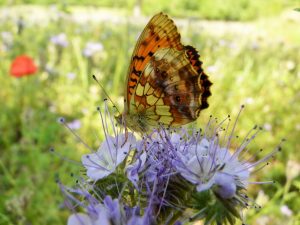
Marbled Fritillary Brenthis daphne, The Vercors
A colourful character
One of the most striking of Europe’s collection of fritillaries, the Marbled Fritillary is a species of scrubby areas. With just a single summer-flying generation, the Marbled Fritillary like many butterflies needs good habitat structure: its larvae feed on Bramble and the adults nectar at various flowers, as well as needing warm, sheltered spots to bask in.
Of all the fritillaries, I was pleased to see this one pop up on #FebruaryButterflyMonth as it is one of my favourites (not that I have favourites of course)!
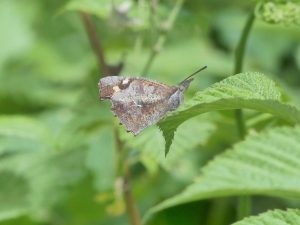
Nettle Tree Butterfly Libythea celtis, Bulgaria
The one and only
The pleasingly angular Nettle Tree Butterfly is the only member of the Libytheinae found in Europe. These are a sub-family of the Nympahlids and are otherwise known as the snout butterflies, and in side profile you can see exactly why this common name stuck.
The ‘snout’ is formed by the palpi. These are usually covered in hairs, and are thought to form part of a butterfly’s olfactory armoury, alongside it’s legs, proboscis and antennae, which between them, help it to smell or taste potential food sources, as well as pheromones important in finding a mate, and potential egg-laying sites.
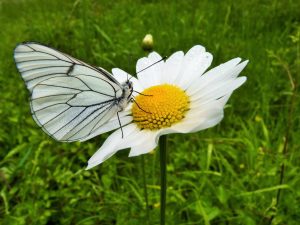
Black-veined White Aporia crataegi, The Vercors
Friends in high places
Another former resident, the Black-veined White, once found in southern England, disappeared without explanation in the 1920s. It is widespread in Europe where it can be found nectaring around meadows and woody habitat throughout the summer.
The Black-veined White, which was subject to a failed reintroduction attempt by none other than Winston Churchill, is top of the list of species that could return to the UK, as the changing climate makes conditions more suitable for it. Perhaps one day this striped beauty will be cruising the south coast once more.
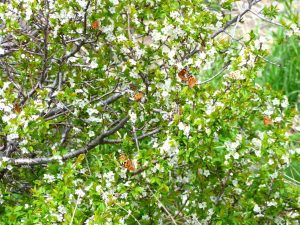
Painted Lady Vanessa cardui, Armenia
A wandering nomad
The Painted Lady is well known for its wandering ways and is certainly the butterfly species I have seen in the most countries. Its impressive migration weighs in at some 9,000 miles and in our part of the world takes them from northern Africa, the Middle East and central Asia northwards, percolating throughout Europe, and in some years reaching the Arctic.
Neither outbound nor return journey is undertaken by one butterfly alone, but is instead a ‘staged migration’, with successive generations carrying out parts of the journey. Research has shown the full migration can involve up to six generations. The use of high altitude winds can make Painted Lady migration go under the radar (although of course it was radar observations that finally proved they do carry out a return southbound migration). When the Painted Lady floodgates are open and they hit the nectar, it is a truly impressive site! This photo was taken in Armenia where many thousands of them were feasting on flowers.
You can revisit #FebruaryButterflyMonth on Twitter and visit the European Butterfly Group to find out lots of interesting and useful information about European butterflies.

